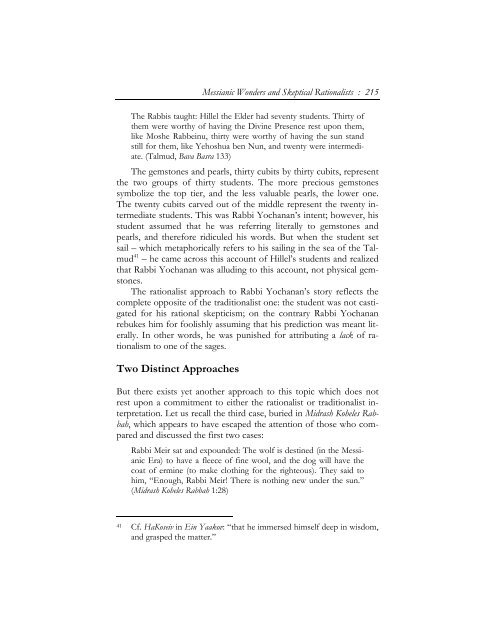Messianic Wonders and Skeptical Rationalists - Hakirah.org
Messianic Wonders and Skeptical Rationalists - Hakirah.org
Messianic Wonders and Skeptical Rationalists - Hakirah.org
You also want an ePaper? Increase the reach of your titles
YUMPU automatically turns print PDFs into web optimized ePapers that Google loves.
<strong>Messianic</strong> <strong>Wonders</strong> <strong>and</strong> <strong>Skeptical</strong> <strong>Rationalists</strong> : 215<br />
The Rabbis taught: Hillel the Elder had seventy students. Thirty of<br />
them were worthy of having the Divine Presence rest upon them,<br />
like Moshe Rabbeinu, thirty were worthy of having the sun st<strong>and</strong><br />
still for them, like Yehoshua ben Nun, <strong>and</strong> twenty were intermediate.<br />
(Talmud, Bava Basra 133)<br />
The gemstones <strong>and</strong> pearls, thirty cubits by thirty cubits, represent<br />
the two groups of thirty students. The more precious gemstones<br />
symbolize the top tier, <strong>and</strong> the less valuable pearls, the lower one.<br />
The twenty cubits carved out of the middle represent the twenty intermediate<br />
students. This was Rabbi Yochanan’s intent; however, his<br />
student assumed that he was referring literally to gemstones <strong>and</strong><br />
pearls, <strong>and</strong> therefore ridiculed his words. But when the student set<br />
sail – which metaphorically refers to his sailing in the sea of the Talmud<br />
41 – he came across this account of Hillel’s students <strong>and</strong> realized<br />
that Rabbi Yochanan was alluding to this account, not physical gemstones.<br />
The rationalist approach to Rabbi Yochanan’s story reflects the<br />
complete opposite of the traditionalist one: the student was not castigated<br />
for his rational skepticism; on the contrary Rabbi Yochanan<br />
rebukes him for foolishly assuming that his prediction was meant literally.<br />
In other words, he was punished for attributing a lack of rationalism<br />
to one of the sages.<br />
Two Distinct Approaches<br />
But there exists yet another approach to this topic which does not<br />
rest upon a commitment to either the rationalist or traditionalist interpretation.<br />
Let us recall the third case, buried in Midrash Koheles Rabbah,<br />
which appears to have escaped the attention of those who compared<br />
<strong>and</strong> discussed the first two cases:<br />
Rabbi Meir sat <strong>and</strong> expounded: The wolf is destined (in the <strong>Messianic</strong><br />
Era) to have a fleece of fine wool, <strong>and</strong> the dog will have the<br />
coat of ermine (to make clothing for the righteous). They said to<br />
him, “Enough, Rabbi Meir! There is nothing new under the sun.”<br />
(Midrash Koheles Rabbah 1:28)<br />
41 Cf. HaKoseiv in Ein Yaakov: “that he immersed himself deep in wisdom,<br />
<strong>and</strong> grasped the matter.”
















